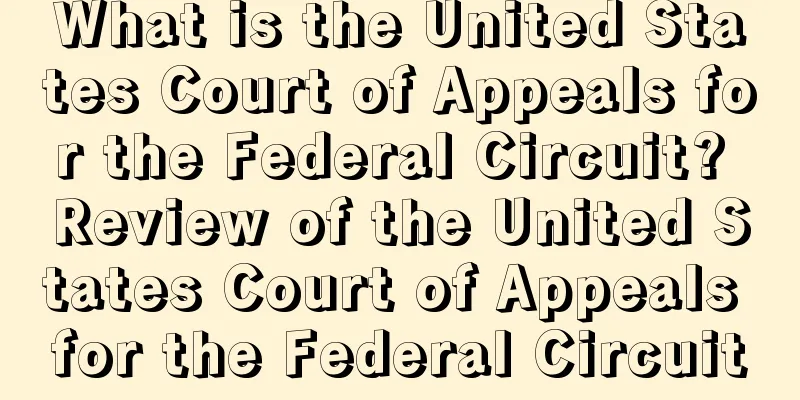What is the United States Court of Appeals for the Federal Circuit? Review of the United States Court of Appeals for the Federal Circuit

|
The United States Court of Appeals for the Federal Circuit (or Federal Circuit Court of Appeals, often abbreviated as Fed. Cir. or CAFC in legal references) is a federal appellate court located in Washington, D.C. The court was created by the United States Congress through the Federal Courts Improvement Act of 1982, which merged the original Federal Court of Customs and Patent Appeals and the Appellate Division of the United States Court of Claims, making the judges of these courts circuit appellate judges. Official website : https://cafc.uscourts.gov/ Established on October 1, 1982 The United States Court of Appeals for the Federal Circuit is one of 13 circuit courts of appeals in the United States federal court system and is located in Washington, D.C. The CAFC was the latest of the 13 appellate courts and is also the most unique. Unlike the other 12 circuit courts of appeals, its jurisdiction is determined based on the subject matter of the case rather than geographical location. The most familiar function of CAFC is to serve as the exclusive appellate court for patent confirmation and infringement litigation . It accepts appeals from the US Patent and Trademark Office on patent examination cases , US District Court (DCT) patent infringement cases , and " 337 investigation" cases from the US International Trade Commission (ITC). Since its establishment, about one-third of the cases heard by the US Court of Appeals for the Federal Circuit involve patents. Many important decisions of CAFC on patent cases have played an extremely important role in the development of the US patent system. However, the cases under the jurisdiction of CAFC are not limited to patents. Moreover, it is worth noting that CAFC does not have jurisdiction over copyright-related cases, which belong to the category of intellectual property. Background The United States Court of Appeals for the Federal Circuit was established in 1982. Prior to this, appeals from the United States Patent and Trademark Office were heard by the United States Court of Customs and Patent Appeals, and appeals from patent infringement cases in the United States district courts were heard by the appellate courts of the corresponding circuits (the 1st to 11th Circuit Courts of Appeals and the District of Columbia Circuit Court of Appeals). However, on the one hand, in addition to legal issues, patent cases usually involve complex technical issues, requiring judges to have both technical and legal qualities, which ordinary courts do not have; on the other hand, different appellate courts may make different judgments for similar or even the same facts, and their judgments are not binding on each other, resulting in inconsistent trial standards and seriously affecting the predictability of judgments. In order to resolve these contradictions, the United States Congress passed the Federal Court Improvement Act in 1982. Based on this act, on October 1, 1982, the United States Court of Appeals for the Federal Circuit was established by merging the appellate departments of the original United States Court of Customs and Patent Appeals and the United States Court of Claims. jurisdiction The jurisdiction of the CAFC is generally governed by 28 U.S.C. § 1295. The CAFC hears appeals from all U.S. federal district courts and certain administrative agencies, as well as appeals based on certain statutory provisions. The CAFC has exclusive jurisdiction over appeals from: The United States Court of Appeals for the Federal Circuit is unique among the 13 circuits in that it has nationwide jurisdiction over a variety of subject areas, including international trade, government contracts, patents, trademarks, certain money claims against the United States government, federal personnel, veterans' benefits, and public safety officer benefit claims. Appeals to the Federal Circuit come from all federal district courts, the U.S. Court of Federal Claims, the U.S. Court of International Trade, and the U.S. Court of Appeals for Veterans Claims. The Federal Circuit also reviews decisions of certain administrative agencies, including those from the United States Trademark Review and Adjudication Board, the Patent Appeals and Interferences Board of the United States Patent and Trademark Office, the Board of Contract Appeals, the Merit Systems Protection Board, the Congressional Compliance Office, the Government Accountability Office’s Board of Personnel Appeals, and the United States International Trade Commission. The Federal Circuit does not have jurisdiction over any criminal, bankruptcy, immigration, or state matters. The Federal Circuit also cannot hear appeals of decisions of other U.S. appellate courts; appeals from other U.S. appellate courts go directly to the U.S. Supreme Court. Generally speaking, all appeals from any U.S. federal district court are heard by the CAFC as long as the original lawsuit contains a claim based on patent law. However, according to the decision of the U.S. Supreme Court, if the patent claim is merely a counterclaim filed by the defendant, it does not necessarily have to be heard by the CAFC. However, although other appellate courts can theoretically hear patent counterclaims, in practice this does not often happen. One of the unique features of the CAFC is that its decisions, especially those concerning patent cases, become binding precedents throughout the United States. This is different from the other 12 federal appellate courts, whose decisions only become binding precedents within the geographic areas they are responsible for. CAFC decisions can only be overturned by a decision of the United States Supreme Court or a relevant change in the statute. Since whether to review the CAFC's decision depends on the discretion of the United States Supreme Court, in practice, the CAFC's decision is final in most cases, especially since the CAFC has exclusive jurisdiction over relevant matters and there is no so-called "circuit split" (that is, the appellate courts in different circuits disagree on the interpretation of federal law). Office Location The offices of CCAFC are located in the Howard T. Markey NationalCourts Building, Benjamin Ogle Tayloe House, the former Cosmos Club and Cutts-Madison House in the District of Columbia. The court sometimes holds sessions outside of Washington. In addition, CAFC judges can also participate in cases in other federal appellate courts and federal district courts based on assignment. Because CAFC's jurisdiction extends throughout the United States, the court can hold collegial panels anywhere in the country. CAFC usually holds oral hearings in cities outside of Washington once or twice a year. Collegial panels can be located in federal courts, state courts, or even university law schools. References
|
<<: What is Yanglaoban.com? Yanglaoban.com Review
>>: What is an A-to-Z claim? A-to-Z claim review
Recommend
More than 110,000 mattresses recalled by CPSC! Available on Amazon and other platforms
It is learned that the U.S. Consumer Product Safet...
What is Sellozo? Sellozo Review
Sellozo is an Amazon seller advertising optimizati...
Musk plans to lay off 3,700 people at Twitter and will cancel remote work
It is learned that billionaire Musk plans to annou...
Home e-commerce company Overstock: The BNPL boom is entering the low-order market
It is learned that according to the latest report ...
Unscrupulous companies withhold wages. Everyone who joins Amazon must beware of such villains.
I joined a company in Baoan, Shenzhen right after ...
What is AliExpress Through Train? AliExpress Through Train Review
AliExpress Express is a new online promotion metho...
Amazon implements new product regulations! Products that do not comply will be removed from shelves for rectification
If Amazon sellers want to expand into the Europea...
Get ahead of the season! Target will start its holiday sale on October 10th!
<span data-shimo-docs="[[20,"旺季抢跑!Target 将...
US retailers face tough transition as suppliers forced to cut purchases
US retailers are in an unprecedented inventory cri...
How to form Amazon related sales and common related sales methods
"Related sales" seems to be something t...
What is Amazon DSP? Amazon DSP Review
Amazon DSP (Demand-side Platform) is one of Amazon...
What is Lifehacker? Lifehacker Review
Lifehacker is a famous American blog on life and s...
Nearly 1,000 people were laid off! E-commerce giant Shopify also couldn't escape the wave of layoffs!
In the past two years, the epidemic has driven the...
Snapchat acquires Vertebrae, targeting AR e-commerce market
According to foreign media reports, Snapchat recen...
What is Chaoxi International Logistics? Chaoxi International Logistics Review
Xiamen Chaoxi International Freight Forwarding Co....









